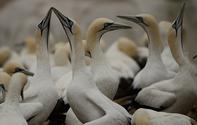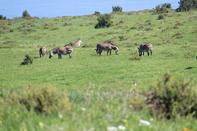At the mouth of the Langebaan Lagoon lies Saldanha Bay with its numerous islands, which, together with the nearby Bird Island at Lambert's Bay, are all important breeding colonies for seabirds.

On Malgas Island in Saldanha Bay and on Bird Island nearly half of the world's Cape Gannets (Morus capensis) breed in two tightly packed colonies, where elaborate social and mating rituals are used to avoid conflict. These large diving birds can land vertically but they need a good run to take off, so runways are established and kept clear by communal consent.
Apart from the significant gannet population, collectively the islands of Saldanha Bay are home to 15 percent of all the world's crowned cormorants, the largest breeding colony of bank cormorants, 12 percent of all black oystercatchers, as well as to large colonies of Cape and white-breasted cormorants, sea-gulls and jackass penguins.
More than half the world's population of the southern African subspecies of swift tern (Sterna bergii) breeds on Marcus Island alone. What all of these birds have in common is that they feed on pelagic fish, but subsequent to the commercial over-exploitation of this resource the dependent bird populations have been drastically reduced by up to 95 per cent in the case of the jackass penguin (Spheniscus demersus).
During the construction of the harbour for the export of iron ore at Saldanha, drastic disruptions were caused to the island breeding sites and large numbers of birds were blown up in blasting operations to deepen the entrance to the bay.
Since then a national park has been proclaimed at Langebaan, but the real epilogue to this tale is that the warnings of planners and ecologists have come to pass, with the harbour at Saldanha and the railway to Sishen proving to be an environmental and economic failure.
Area Around Langebaan

What did the world look like five million years ago, some two million before the first ape-people appeared on the scene? The area around Langebaan in the West Coast National Park was very different to what it is today, more like an estuary on the East African coast with the sea much higher and colder the land much warmer and wetter.
And there were many strange creatures, the forebears of animals we know today, including a giant bear that is the largest carnivore known after the demise of the dinosaurs.
There were also massive short-necked and long-horned giraffes, dwarf pigs, giant buffaloes and hyenas among the 200 species of extinct mammals, birds, fish and other very strange life forms uncovered in the old Chemfos phosphate works at Langebaanweg. You'll find some of the things you'll see, preserved right there in the ground, hard to believe. A visit to the park really is an amazing experience.